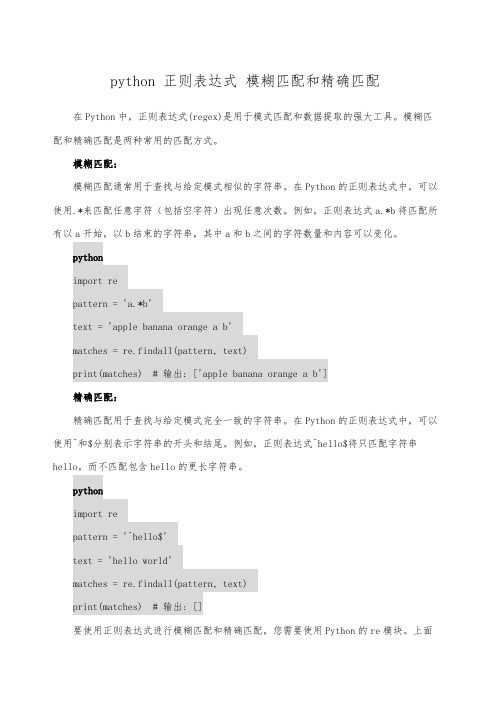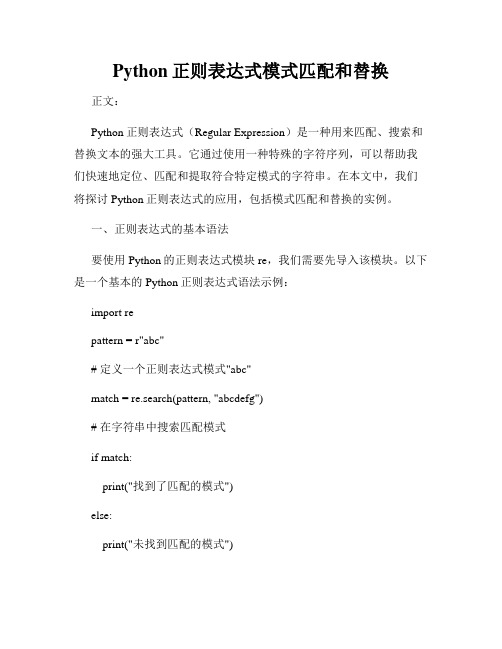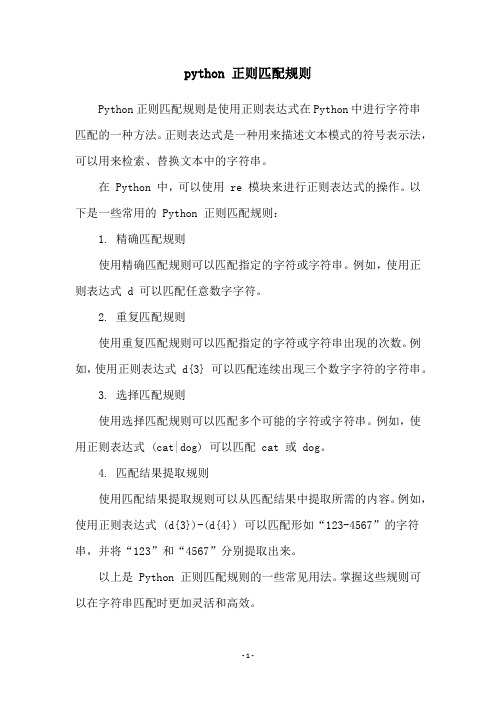【IT专家】在Python中逐步查找流数据中的正则表达式匹配
python 正则表达式 模糊匹配和精确匹配

python 正则表达式模糊匹配和精确匹配在Python中,正则表达式(regex)是用于模式匹配和数据提取的强大工具。
模糊匹配和精确匹配是两种常用的匹配方式。
模糊匹配:模糊匹配通常用于查找与给定模式相似的字符串。
在Python的正则表达式中,可以使用.*来匹配任意字符(包括空字符)出现任意次数。
例如,正则表达式a.*b将匹配所有以a开始,以b结束的字符串,其中a和b之间的字符数量和内容可以变化。
pythonimport repattern = 'a.*b'text = 'apple banana orange a b'matches = re.findall(pattern, text)print(matches) # 输出: ['apple banana orange a b']精确匹配:精确匹配用于查找与给定模式完全一致的字符串。
在Python的正则表达式中,可以使用^和$分别表示字符串的开头和结尾。
例如,正则表达式^hello$将只匹配字符串hello,而不匹配包含hello的更长字符串。
pythonimport repattern = '^hello$'text = 'hello world'matches = re.findall(pattern, text)print(matches) # 输出: []要使用正则表达式进行模糊匹配和精确匹配,您需要使用Python的re模块。
上面的例子演示了如何使用re模块的findall函数来查找与给定模式匹配的所有字符串。
python 匹配正则

python 匹配正则正则表达式是一种强大的文本匹配工具,Python中也提供了re 模块来支持正则表达式的使用。
本文将通过一些简单的例子来介绍Python中如何使用正则表达式进行匹配。
1.基础正则表达式正则表达式的基本语法如下:. 匹配任意单个字符d 匹配数字,相当于[0-9]w 匹配字母、数字、下划线,相当于[A-Za-z0-9_]s 匹配空格、制表符、换行符等空白字符[] 匹配括号中的任意一个字符| 匹配左右两边的任意一个表达式() 分组,可以用于后续的引用例如:import re# 匹配以a开头的字符串result = re.match('a', 'abc')print(result.group()) # a# 匹配数字result = re.match('d', '123')print(result.group()) # 1# 匹配字母、数字、下划线result = re.match('w', 'a_1')print(result.group()) # a# 匹配空白字符result = re.match('s', ' a')print(result.group()) # (一个空格)2.量词量词用于控制匹配的次数,常见的量词包括: * 匹配前面的字符0次或多次+ 匹配前面的字符1次或多次匹配前面的字符0次或1次{n} 匹配前面的字符恰好n次{n,} 匹配前面的字符至少n次{n,m} 匹配前面的字符至少n次,至多m次例如:import re# 匹配a出现0次或多次result = re.match('a*', 'aaabbb')print(result.group()) # aaa# 匹配a出现1次或多次result = re.match('a+', 'aaabbb')print(result.group()) # aaa# 匹配a出现0次或1次result = re.match('a?', 'aaabbb')print(result.group()) # a# 匹配a出现3次result = re.match('a{3}', 'aaabbb')print(result.group()) # aaa# 匹配a出现至少2次result = re.match('a{2,}', 'aaabbb')print(result.group()) # aaa# 匹配a出现至少1次,至多3次result = re.match('a{1,3}', 'aaabbb')print(result.group()) # aaa3.字符集字符集用于匹配一组字符中的任意一个,常见的字符集包括: [abc] 匹配a、b、c中的任意一个字符[a-z] 匹配a到z中的任意一个小写字母[A-Z] 匹配A到Z中的任意一个大写字母[0-9] 匹配0到9中的任意一个数字[^a] 匹配除了a以外的任意一个字符例如:import re# 匹配a、b、c中的任意一个字符result = re.match('[abc]', 'b')print(result.group()) # b# 匹配a到z中的任意一个小写字母result = re.match('[a-z]', 'c')print(result.group()) # c# 匹配A到Z中的任意一个大写字母result = re.match('[A-Z]', 'C')print(result.group()) # C# 匹配0到9中的任意一个数字result = re.match('[0-9]', '7')print(result.group()) # 7# 匹配除了a以外的任意一个字符result = re.match('[^a]', 'b')print(result.group()) # b4.特殊字符特殊字符用于匹配一些特殊的字符,常见的特殊字符包括:匹配转义字符,例如匹配点号.可以使用.^ 匹配字符串的开头$ 匹配字符串的结尾b 匹配单词边界B 匹配非单词边界例如:import re# 匹配转义字符,例如匹配点号可以使用.result = re.match('a.b', 'a.b')print(result.group()) # a.b# 匹配字符串的开头result = re.match('^abc', 'abcdef')print(result.group()) # abc# 匹配字符串的结尾result = re.match('abc$', 'defabc')print(result.group()) # abc# 匹配单词边界result = re.findall(r'btheb', 'the cat in the hat')print(result) # ['the', 'the']# 匹配非单词边界result = re.findall(r'BtheB', 'themethecatinthehat') print(result) # ['the', 'the']以上就是Python中使用正则表达式进行匹配的基础知识,希望对大家有所帮助。
Python正则表达式指南学会使用正则表达式进行文本匹配

Python正则表达式指南学会使用正则表达式进行文本匹配Python正则表达式指南正则表达式是一种强大的文本模式匹配工具,可以用于查找、替换和验证文本数据。
在Python中,使用内置的re模块可以轻松地处理正则表达式。
一、正则表达式的基本概念正则表达式是一种使用特殊符号和字符组成的模式,用于匹配与之相符合的文本。
下面是一些常用的正则表达式元字符和语法规则:1. 元字符- . : 匹配任意单个字符。
- ^ : 匹配字符串的开始位置。
- $ : 匹配字符串的结束位置。
- * : 匹配前一个字符的0次或多次重复。
- + : 匹配前一个字符的1次或多次重复。
- ? : 匹配前一个字符的0次或1次重复。
- {n} : 匹配前一个字符的n次重复。
- {m,n} : 匹配前一个字符的m到n次重复。
- [...] : 匹配方括号内的任意一个字符。
- [^...] : 匹配除方括号内的字符之外的任意一个字符。
- (...) : 分组匹配。
2. 语法规则- \ : 转义字符,用于匹配元字符本身。
- | : 或,匹配多个模式中的一个。
- \d : 匹配任意数字字符。
- \D : 匹配任意非数字字符。
- \w : 匹配任意字母、数字或下划线字符。
- \W : 匹配任意非字母、数字或下划线字符。
- \s : 匹配任意空白字符。
- \S : 匹配任意非空白字符。
二、Python re模块的常用方法Python的re模块提供了一系列函数,用于处理正则表达式。
1. re.match(pattern, string)- 从字符串的开始位置匹配指定的模式,返回匹配对象。
2. re.search(pattern, string)- 扫描整个字符串,返回第一个满足匹配条件的结果,返回匹配对象。
3. re.findall(pattern, string)- 找到所有满足匹配条件的结果,返回一个列表。
4. re.sub(pattern, repl, string)- 在字符串中找到匹配的模式并替换为指定的字符串。
python 正则匹配提取

python 正则匹配提取正则表达式是一种强大的工具,用于在文本中搜索特定模式的字符串。
在Python中,我们可以使用内置的re模块来进行正则表达式的匹配和提取。
首先,我们需要导入re模块:python.import re.接下来,假设我们有一个字符串,我们想从中提取特定模式的内容。
例如,假设我们有一个包含邮箱地址的字符串,我们想提取所有的邮箱地址。
我们可以使用re模块的findall函数来实现这一点:python.text = "我的邮箱是****************,另一个邮箱是***************"emails = re.findall(r'[\w\.-]+@[\w\.-]+', text)。
print(emails)。
在这个例子中,我们使用了正则表达式`r'[\w\.-]+@[\w\.-]+'`来匹配邮箱地址。
这个正则表达式表示匹配由字母、数字、下划线、句点或连字符组成的邮箱地址。
findall函数会返回所有匹配的结果。
除了findall函数,re模块还提供了其他函数,比如search和match,它们可以用来在文本中搜索匹配的内容,并返回匹配对象。
另外,我们还可以使用正则表达式来提取字符串中的特定部分,比如提取日期、电话号码等。
通过使用分组,我们可以指定要提取的部分,然后通过group方法来获取提取的结果。
总的来说,正则表达式在Python中的应用非常灵活,可以用来匹配和提取各种类型的文本内容。
当然,使用正则表达式需要谨慎,因为复杂的正则表达式可能会导致性能问题,并且有时候难以理解和维护。
因此,在实际应用中,需要权衡使用正则表达式和其他方法来处理文本内容。
python list 查找 正则

python list 查找正则如何使用Python 的列表(list) 查找字符串内的匹配模式(正则表达式)。
步骤一:导入正则模块要在Python 中使用正则表达式,首先需要导入re 模块。
在Python 中,re 模块提供了一套丰富且功能强大的正则表达式操作函数。
pythonimport re步骤二:定义要搜索的列表在开始查找之前,我们需要定义一个要搜索的列表。
列表是Python 中一种非常常用的数据结构,它可以容纳任意数量的元素。
使用列表时,请确保列表中的元素是字符串类型,因为我们将对其进行正则表达式匹配。
pythonmy_list = ['apple', 'banana', 'cherry', 'date', 'elderberry']步骤三:编写正则表达式接下来,我们需要编写一个正则表达式,用于定义我们要查找的模式。
正则表达式是一种特定的语法模式,用于描述字符串的模式,并根据模式进行匹配。
Python 的re 模块提供了丰富的正则表达式语法。
例如,假设我们要查找以字母'a' 开头的单词,我们可以使用正则表达式模式`^a\w*`:- `^` 表示匹配字符串的开头- `a` 表示字母'a'- `\w*` 表示由任意数量的字母或数字字符构成的单词pythonpattern = '^a\w*'步骤四:使用正则表达式进行匹配接下来,我们可以开始使用正则表达式对列表中的元素进行匹配。
可以使用re 模块的`search()` 函数进行匹配,该函数将返回第一个满足正则表达式的结果。
pythonfor word in my_list:match = re.search(pattern, word)if match:print(word)在上述代码中,我们遍历了列表中的每个单词,并对每个单词使用正则表达式进行匹配。
Python正则表达式模式匹配和替换

Python正则表达式模式匹配和替换正文:Python正则表达式(Regular Expression)是一种用来匹配、搜索和替换文本的强大工具。
它通过使用一种特殊的字符序列,可以帮助我们快速地定位、匹配和提取符合特定模式的字符串。
在本文中,我们将探讨Python正则表达式的应用,包括模式匹配和替换的实例。
一、正则表达式的基本语法要使用Python的正则表达式模块re,我们需要先导入该模块。
以下是一个基本的Python正则表达式语法示例:import repattern = r"abc"# 定义一个正则表达式模式"abc"match = re.search(pattern, "abcdefg")# 在字符串中搜索匹配模式if match:print("找到了匹配的模式")else:print("未找到匹配的模式")以上代码中,我们首先导入re模块,然后定义一个字符串模式"abc",接着使用re模块的search函数,在字符串"abcdefg"中搜索是否存在匹配模式"abc"。
如果找到则输出"找到了匹配的模式",否则输出"未找到匹配的模式"。
二、元字符和限定符在正则表达式中,有一些特殊字符被称为元字符,用于表示模式中的一些特定意义。
例如,使用点号(.)表示任何字符,而使用星号(*)表示任意数量的前一个字符。
以下是一些常用的元字符和限定符的示例:- . :匹配任意单个字符- * :匹配前一个字符的零次或多次出现- + :匹配前一个字符的一次或多次出现- ? :匹配前一个字符的零次或一次出现- \d :匹配任意一个数字- \w :匹配任意一个字母或数字或下划线- \s :匹配任何空白字符三、模式匹配与提取除了基本的元字符和限定符,正则表达式还可以使用一些特殊的语法来进行模式匹配和提取。
python中正则表达式的使用详解

python中正则表达式的使⽤详解从学习Python⾄今,发现很多时候是将Python作为⼀种⼯具。
特别在⽂本处理⽅⾯,使⽤起来更是游刃有余。
说到⽂本处理,那么正则表达式必然是⼀个绝好的⼯具,它能将⼀些繁杂的字符搜索或者替换以⾮常简洁的⽅式完成。
我们在处理⽂本的时候,或是查询抓取,或是替换.⼀.查找如果你想⾃⼰实现这样的功能模块,输⼊某⼀个ip地址,得到这个ip地址所在地区的详细信息.但是⼈家没有提供api供外部调⽤,但是我们可以通过代码模拟查询然后对结果进⾏抓取.通过查看这个相应页⾯的源码,我们可以发现,结果是放在三个<li></li>中的复制代码代码如下:<table width="80%" border="0" align="center" cellpadding="0" cellspacing="0"><tr><td align="center"><h3> IP查询(搜索IP地址的地理位置)</h3></td></tr><tr><td align="center"><h1>您查询的IP:121.0.29.231</h1></td></tr><tr><td align="center"><ul class="ul1"><li>本站主数据:浙江省杭州市阿⾥巴巴</li><li>参考数据⼀:浙江省杭州市阿⾥巴巴</li><li>参考数据⼆:浙江省杭州市阿⾥巴巴</li></ul></td></tr><tr><td align="center">如果您发现查询结果不详细或不正确,请使⽤<a href="ip_add.asp?ip=121.0.29.231"><fontcolor="#006600"><b>IP数据库⾃助添加</b></font></a>功能进⾏修正<br/><br/><iframe src="/jss/bd_460x60.htm" frameborder="no" width="460" height="60" border="0" marginwidth="0" marginheight="0" scrolling="no"></iframe><br/><br/></td></tr><form method="get" action="ips8.asp" name="ipform" onsubmit="return checkIP();"><tr><td align="center">IP地址或者域名:<input type="text" name="ip" size="16"> <input type="submit" value="查询"><input type="hidden" name="action" value="2"></td></tr><br><br></form></table>如果你了解正则表达式你可能会写出正则表达式复制代码代码如下:(?<=<li>).*?(?=</li>)这⾥使⽤了前瞻:lookahead 后顾: lookbehind,这样的好处就是匹配的结果中就不会包含html的li标签了.如果你对⾃⼰写的正则表达式不是很⾃信的话,可以在⼀些在线或者本地的正则测试⼯具进⾏⼀些测试,以确保正确.接下来的⼯作就是如果⽤Python实现这样的功能,⾸先我们得将正则表达式表⽰出来:复制代码代码如下:r"(?<=<li>).*?(?=</li>)"Python中字符串前⾯加上前导r这个字符,代表这个字符串是R aw String(原始字符串),也就是说Python字符串本⾝不会对字符串中的字符进⾏转义.这是因为正则表达式也有转义字符之说,如果双重转义的话,易读性很差.这样的串在Python中我们把它叫做"regular expression pattern"如果我们对pattern进⾏编译的话复制代码代码如下:prog = pile(r"(?<=<li>).*?(?=</li>)")我们便可以得到⼀个正则表达式对象regular expression object,通过这个对象我们可以进⾏相关操作.⽐如复制代码代码如下:result=prog.match(string)##这个等同于result=re.match(r"(?<=<li>).*?(?=</li>)",string)##但是如果这个正则需要在程序匹配多次,那么通过正则表达式对象的⽅式效率会更⾼接下来就是查找了,假设我们的html结果已经以html的格式存放在text中,那么通过复制代码代码如下:result_list = re.findall(r"(?<=<li>).*?(?=</li>)",text)便可以取得所需的结果列表.⼆.替换使⽤正则表达式进⾏替换⾮常的灵活.⽐如之前我在阅读Trac这个系统中wiki模块的源代码的时候,就发现其wiki语法的实现就是通过正则替换进⾏的.在使⽤替换的时候会涉及到正则表达式中的Group分组的概念.假设wiki语法中使⽤!表⽰转义字符即感叹号后⾯的功能性字符会原样输出,粗体的语法为写道'''这⾥显⽰为粗体'''那么有正则表达式为复制代码代码如下:r"(?P<bold>!?''')"这⾥的?P<bold>是Python正则语法中的⼀部分,表⽰其后的group的名字为"bold"下⾯是替换时的情景,其中sub函数的第⼀个参数是pattern,第⼆个参数可以是字符串也可以是函数,如果是字符串的话,那么就是将⽬标匹配的结果替换成指定的结果,⽽如果是函数,那么函数会接受⼀个match object的参数,并返回替换后的字符串,第三个参数便是源字符串.复制代码代码如下:result = re.sub(r"(?P<bold>!?''')", replace, line)每当匹配到⼀个三单引号,replace函数便运⾏⼀次,可能这时候需要⼀个全局变量记录当前的三单引号是开还是闭,以便添加相应的标记.在实际的trac wiki的实现的时候,便是这样通过⼀些标记变量,来记录某些语法标记的开闭,以决定replace函数的运⾏结果.--------------------⽰例⼀. 判断字符串是否是全部⼩写代码复制代码代码如下:# -*- coding: cp936 -*-import res1 = 'adkkdk's2 = 'abc123efg'an = re.search('^[a-z]+$', s1)if an:print 's1:', an.group(), '全为⼩写'else:print s1, "不全是⼩写!"an = re.match('[a-z]+$', s2)if an:print 's2:', an.group(), '全为⼩写'else:print s2, "不全是⼩写!"结果究其因1. 正则表达式不是python的⼀部分,利⽤时需要引⽤re模块2. 匹配的形式为: re.search(正则表达式,带匹配字串)或re.match(正则表达式,带匹配字串)。
python的正则表达式速查表与实操手册

正则表达式是一种强大的文本匹配工具,它可以用来搜索、替换和分析文本数据。
Python作为一种流行的编程语言,内置了正则表达式模块re,通过使用re模块,我们可以在Python中轻松地实现正则表达式的功能。
本文将为大家提供Python的正则表达式速查表与实操手册,帮助大家更好地掌握Python正则表达式的用法。
一、基本概念1. 正则表达式的概念正则表达式是用来描述字符串匹配模式的一种工具,它由普通字符和特殊字符组成,可以用来匹配和查找字符串中的特定模式。
2. re模块的使用Python中的re模块为我们提供了操作正则表达式的功能,通过使用re模块,我们可以实现字符串的匹配、查找、替换等操作。
二、基本语法1. 匹配单个字符- .:匹配任意字符(除了换行符)- [ ]:匹配方括号中的任意一个字符- \d:匹配数字- \s:匹配空白字符- \w:匹配字母、数字、下划线2. 匹配多个字符- *:匹配前面的字符0次或多次- +:匹配前面的字符1次或多次- ?:匹配前面的字符0次或1次- {m}:匹配前面的字符m次- {m,n}:匹配前面的字符m到n次3. 边界匹配- ^:匹配字符串开头- $:匹配字符串结尾- \b:匹配单词边界4. 分组和引用- ( ):用来表示一组字符- |:表示或关系- \1, \2:引用匹配到的内容三、实操手册1. 匹配字符串import repattern = 'foo'text = 'foobaz'match = re.match(pattern, text)if match:print('匹配成功', match.group())else:print('匹配失败')2. 查找字符串pattern = 'foo'text = 'foobazfoo'matches = re.findall(pattern, text)for match in matches:print('匹配成功', match)3. 替换字符串pattern = 'foo'text = 'foobazfoo'new_text = re.sub(pattern, 'bar', text)print('替换后的文本', new_text)通过以上实操手册的例子,我们可以清楚地了解到Python中正则表达式的使用方法。
python正则表达式匹配函数

python正则表达式匹配函数Python正则表达式匹配函数是实现文本匹配的一种强大的工具。
在Python中,正则表达式可以用来搜索、替换、分割和验证文本。
一、什么是正则表达式正则表达式是用来描述字符串的一种方式。
它可以描述一个字符串的结构和特征,从而可以用来匹配字符串。
正则表达式使用一种语法来描述字符串,这种语法非常灵活,可以匹配各种形式的字符串。
二、Python正则表达式模块Python中的正则表达式模块是re模块,通过它可以使用正则表达式来处理字符串。
要使用Python的正则表达式模块,需要先导入re模块:import re三、Python正则表达式匹配函数Python的re模块提供了很多匹配函数,包括:1. re.match():从字符串的起始位置开始匹配模式,如果不是起始位置开始匹配,就匹配不到。
2. re.search():扫描整个字符串并返回第一个成功的匹配。
3. re.findall():在字符串中搜索所有符合正则表达式的字串,并返回一个列表。
4. re.sub():替换字符串中所有匹配到的正则表达式的字串。
5. re.split():按照正则表达式的模式,分割字符串,并返回一个列表。
四、Python正则表达式语法Python正则表达式的语法非常灵活,可以匹配各种形式和结构的字符串。
其中一些常见的语法包括:1. 用圆括号()表示一个组,()中的内容是一个子表达式。
2. | 表示或,表示匹配 | 左边或右边的子表达式。
3. [] 表示一个字符集,表示匹配括号中的其中一个字符。
4. * 表示匹配前一个字符0次或多次。
5. + 表示匹配前一个字符1次或多次。
6. ? 表示匹配前一个字符0次或1次。
7. ^ 表示匹配行首。
8. $ 表示匹配行尾。
五、Python正则表达式实例演示下面是一个简单的例子,展示了如何使用Python的正则表达式来匹配字符串。
例子:匹配字符串中的数字import re# 定义一个字符串str = 'hello123!'# 匹配字符串中的数字result = re.findall('\d+', str)# 输出匹配的结果print(result)在上面的例子中,我们使用了re模块的findall()函数来查找数字。
python匹配正则表达式

python匹配正则表达式正则表达式(Regular Expression)是一种用来匹配字符串的强大工具,它在数据处理中得到了广泛的应用。
Python作为一门高效且易于学习的编程语言,自然不会错过正则表达式的应用。
在Python中,我们可以通过re模块来进行正则表达式的匹配,本文将为大家介绍re 模块的相关知识。
1. re模块的基本介绍re模块是Python用于正则表达式操作的基本模块,它提供了一系列函数用于对字符串进行匹配和查找。
使用re模块之前,需要先进行模块的导入:import re2. re模块的基本函数2.1 匹配函数match()函数match()用来检查字符串是否以某个指定的模式开头。
语法如下:re.match(pattern, string, flags=0)其中,参数pattern表示要匹配的正则表达式,参数string表示要匹配的字符串,参数flags表示匹配模式,常见的匹配模式有:- re.I:忽略大小写- re.M:多行匹配,改变^和$的行为- re.S:让'.'匹配任何字符,包括换行符- re.U:考虑Unicode字符- re.X:正则表达式内的空格和注释将被忽略掉如果匹配成功,该函数会返回一个匹配对象,如果匹配失败,则返回None。
下面是一个例子:import res = 'hello, world!'pattern = r'hello'result = re.match(pattern, s)if result:print('Matched:', result.group())else:print('Not Matched')输出结果为:Matched: hello这个例子检查了字符串s是否以hello开头,由于s的开头正好是hello,因此匹配成功,返回了一个匹配对象。
2.2 搜索函数search()函数search()用来搜索字符串中的指定模式,如果能找到,则返回一个匹配对象。
pyqt正则表达式匹配

pyqt正则表达式匹配引言正则表达式是一种强大的文本模式匹配工具,而在PyQt中,正则表达式同样扮演着重要的角色。
它在用户界面设计和输入验证中发挥着关键作用。
本文将深入探讨在PyQt中如何使用正则表达式进行文本匹配,以及在实际应用中的一些注意事项和技巧。
引言部分一:正则表达式的基本概念1.1 正则表达式的定义解释正则表达式是一种用于描述字符模式的字符串,它被广泛用于文本搜索和替换操作。
在PyQt中,可以使用`QRegExp`类或Python内置的`re`模块进行正则表达式的处理。
1.2 基本的正则表达式语法正则表达式语法包括常见字符的匹配、元字符的使用,以及通配符的应用。
了解`.`、``、`+`等基本元字符的含义,以及如何使用`[]`表示字符范围,对于初学者是至关重要的。
1.3 PyQt中正则表达式的特殊性PyQt中的`QRegExp`类对正则表达式进行了封装,提供了一些特殊的功能和接口。
PyQt的正则表达式在处理中文字符、Unicode编码等方面有其独特之处,需要注意其特殊性。
引言部分二:在PyQt中的正则表达式应用2.1 输入验证与过滤在PyQt中,通过将正则表达式应用于输入框,可以实现用户输入的实时验证,确保输入符合特定格式。
利用正则表达式对输入进行过滤,过滤掉非法字符或不符合要求的文本。
2.2 界面元素的匹配与查找在界面设计中,有时需要根据一定的规则匹配和查找特定的文本元素。
利用正则表达式,可以轻松实现对界面文本的搜索和定位。
2.3 数据提取与处理在处理数据时,正则表达式常用于从文本中提取特定格式的数据。
通过合理运用捕获组和反向引用等技巧,可以实现对数据的有效提取和处理。
引言部分三:正则表达式的性能优化3.1 懒惰匹配与贪婪匹配正则表达式中的懒惰匹配和贪婪匹配是影响性能的关键因素。
通过合理设置懒惰或贪婪匹配,可以在性能和准确性之间找到平衡。
3.2 预编译正则表达式对于频繁使用的正则表达式,可以通过预编译的方式提高匹配效率。
python正则表达式匹配数字和小数的方法

python正则表达式匹配数字和小数的方法
使用Python正则表达式可以很方便的匹配数字和小数。
要匹配数字,可以使用 `\d+` 的正则表达式模式。
其中,`\d` 匹配任何数字字符,而 `+` 表示匹配一个或多个数字字符。
例如,如果我们有一个字符串 `text = "123 abc 456"`, 我们可以使用 `re.findall(r'\d+', text)` 来获得所有数字的列表,结果将是
`['123', '456']`。
要匹配小数,可以使用 `\d+\.\d+` 的正则表达式模式。
其中, `\.` 匹配小数点字符。
例如,如果我们有一个字符串 `text = "1.23 abc 4.56"`, 我们可以使用
`re.findall(r'\d+\.\d+', text)` 来获得所有小数的列表,结果将是 `['1.23', '4.56']`。
除此之外,还可以通过使用 `|` 来匹配含有小数或整数的模式。
例如,如果我
们有一个字符串 `text = "1.23 abc 456"`, 我们可以使用 `re.findall(r'\d+\.\d+|\d+', text)`
来获得所有数字和小数的列表,结果将是 `['1.23', '456']`。
总之,使用Python的re模块和正则表达式,我们可以轻松地匹配数字和小数。
这使得我们能够方便地处理文本中的数字和小数,并快速获得我们需要的数据。
python 正则匹配表达式

python 正则匹配表达式Python 正则匹配表达式正则表达式在计算机科学中是一种非常强大的工具,用于匹配和处理字符串。
Python作为一门强大的编程语言,提供了re模块,让我们可以使用正则表达式来进行字符串的匹配、替换、搜索和切割等操作。
本文将深入探讨Python中正则匹配表达式的用法,从最基础的模式匹配开始,逐步展示不同的正则表达式用法和技巧。
第一步:导入re模块在使用正则表达式之前,你需要导入Python的re模块。
可以使用以下代码将re模块导入你的Python脚本中:import re现在我们准备好可以使用re模块的函数和方法了。
第二步:模式匹配正则表达式是通过一系列字符和特殊字符组成的模式,用于匹配和处理字符串。
在Python中,使用re模块的search()函数来进行模式匹配。
下面是一个简单的例子,展示如何使用re模块的search()函数来匹配字符串中的模式:import repattern = r"apple"string = "I have an apple."match = re.search(pattern, string)if match:print("Pattern found!")else:print("Pattern not found!")在这个例子中,我们定义了一个模式pattern,它匹配字符串中的apple。
然后我们使用re模块的search()函数来在字符串string中查找这个模式。
如果找到了匹配的模式,搜索结果会返回一个匹配对象,否则返回None。
通过检查返回的匹配对象是否存在,我们可以判断模式是否在字符串中存在。
第三步:特殊字符和转义在正则表达式中,有一些特殊字符具有特殊的含义,以便在模式匹配时进行更精确的控制。
如果你想要在模式中使用这些特殊字符,你需要使用反斜杠来转义它们。
python通过正则匹配某一单词的所在行的数据的方法

python通过正则匹配某一单词的所在行的数据的方法摘要:1.介绍Python正则表达式的基本概念2.演示使用Python正则表达式匹配某一单词所在行的方法3.代码示例及解释4.拓展:正则表达式的其他应用场景正文:大家好,今天我将向大家介绍如何在Python中通过正则表达式匹配某一单词所在行的数据。
正则表达式是一种强大的文本处理工具,可以用于查找、匹配和替换文本中的特定模式。
在Python中,我们可以使用`re`模块来处理正则表达式。
首先,让我们了解一下Python正则表达式的基本概念。
正则表达式由一系列字符和元字符组成,用于描述文本的模式。
在Python中,常见的正则表达式元字符有:- `.*`:匹配任意字符(除换行符)零次或多次- `*`:匹配任意字符(除换行符)零次或多次,但至少要匹配一次- `+`:匹配任意字符(除换行符)一次或多次- `?`:匹配任意字符(除换行符)零次或一次- `{n}`:匹配任意字符(除换行符)n次- `{n,}`:匹配任意字符(除换行符)n次或多次- `{n,m}`:匹配任意字符(除换行符)n到m次接下来,我们来看如何使用Python正则表达式匹配某一单词所在行的数据。
假设我们有一段文本,如下所示:```appleThis is a fruit.bananaThis is another fruit.```我们想要找到每一行中第一个单词所在的行。
可以使用如下代码实现:```pythonimport retext = """appleThis is a fruit.bananaThis is another fruit."""# 定义正则表达式,匹配单词和其所在行pattern = r"b(w+)bs+(.*)"# 查找匹配项matches = re.findall(pattern, text)# 输出结果for match in matches:print(f"Word: {match[0]}, Line: {match[1]}")```解释一下这段代码:1.导入`re`模块,用于处理正则表达式。
python 正则匹配方法

python 正则匹配方法摘要:一、正则表达式的基本概念二、Python中的正则表达式库三、正则匹配方法1.字符串匹配2.查找替换3.捕获组4.非贪婪匹配5.零宽断言6.正向与反向引用7.选择性匹配8.括号匹配四、实战案例与应用五、总结与拓展正文:一、正则表达式的基本概念正则表达式(Regular Expression,简称:RE)是一种强大的文本处理工具,它可以用来检查、搜索和替换文本。
正则表达式起源于理论计算机科学,后来被广泛应用于文本处理领域。
二、Python中的正则表达式库在Python中,常用的正则表达式库有:1.re:Python标准库,提供正则表达式的基本功能。
2.python-regex:一个更加易于使用的正则表达式库,支持正则表达式的绝大多数功能。
三、正则匹配方法1.字符串匹配使用`re.search()`和`re.match()`方法进行字符串匹配。
前者从字符串的开头进行匹配,后者从字符串的结尾进行匹配。
```pythonimport repattern = r"world"text = "Hello, world!"match = re.search(pattern, text) # 在字符串开头匹配print(match.group()) # 输出:worldmatch = re.match(pattern, text) # 在字符串结尾匹配print(match.group()) # 输出:world```2.查找替换使用`re.sub()`方法进行查找替换。
```pythonimport repattern = r"world"text = "Hello, world!"re.sub(pattern, "Python", text) # 将world替换为Python print(text) # 输出:Hello, Python!```3.捕获组使用圆括号`()`创建捕获组,将匹配到的字符串分组。
python 匹配正则表达式

python 匹配正则表达式Python 是一种流行的编程语言,拥有强大的字符串处理机制。
其中包括使用正则表达式进行文本匹配的功能。
在 Python 中,可以使用 re 模块来进行正则表达式匹配。
Python 中的re 模块提供了许多函数,用于执行正则表达式匹配操作。
其中最常用的函数是 re.search() 和 re.match()。
两个函数都可以用于匹配文本,但它们之间的差异并不显着。
re.search() 函数将搜索整个字符串,直到找到满足正则表达式的第一个匹配项。
一旦找到了匹配项,它就会停止搜索并返回匹配对象。
如果没有找到匹配项,则返回 None。
re.match() 函数将只匹配字符串的开头。
如果字符串的开头没有匹配项,则返回 None。
因此,如果您想要确保整个字符串都符合正则表达式,那么最好使用 re.search() 函数。
下面是一个例子,演示了如何使用 re 模块进行正则表达式匹配:```import re# 定义一个正则表达式regex = r"hello (\w+)"# 定义一个字符串进行匹配text = "hello world"# 使用 re.search() 函数查找匹配项result = re.search(regex, text)# 判断是否找到匹配项if result:# 输出匹配项print(result.group(1))else:print("No match")```上述代码定义了一个以"hello " 开始,后面跟一个单词的正则表达式。
然后,我们将其用于字符串 "hello world" 上进行匹配。
re.search()函数返回了一个匹配对象。
我们可以使用匹配对象的 group() 方法来获取匹配项。
在上面的示例中,我们使用 group(1) 方法获取模式中的第一个捕获组(在这种情况下,仅有一个捕获组)。
详解python里使用正则表达式的全匹配功能

详解python⾥使⽤正则表达式的全匹配功能详解python⾥使⽤正则表达式的全匹配功能python中很多匹配,⽐如搜索任意位置的search()函数,搜索边界的match()函数,现在还需要学习⼀个全匹配函数,就是搜索的字符与内容全部匹配,它就是fullmatch()函数。
例⼦如下:#python 3.6#蔡军⽣#/caimouse/article/details/51749579#import retext = 'This is some text -- with punctuation.'pattern = 'is'print('Text :', text)print('Pattern :', pattern)m = re.search(pattern, text)print('Search :', m)s = re.fullmatch(pattern, text)print('Full match :', s)text = 'is'print('Text :', text)s = re.fullmatch(pattern, text)print('Full match :', s)text = 'iss'print('Text :', text)s = re.fullmatch(pattern, text)print('Full match :', s)结果输出如下:Text : This is some text -- with punctuation.Pattern : isSearch : <_sre.SRE_Match object; span=(2, 4), match='is'>Full match : NoneText : isFull match : <_sre.SRE_Match object; span=(0, 2), match='is'>Text : issFull match : None如有疑问请留⾔或者到本站社区交流讨论,感谢阅读,希望能帮助到⼤家,谢谢⼤家对本站的⽀持!。
python 正则匹配规则

python 正则匹配规则
Python正则匹配规则是使用正则表达式在Python中进行字符串匹配的一种方法。
正则表达式是一种用来描述文本模式的符号表示法,可以用来检索、替换文本中的字符串。
在 Python 中,可以使用 re 模块来进行正则表达式的操作。
以下是一些常用的 Python 正则匹配规则:
1. 精确匹配规则
使用精确匹配规则可以匹配指定的字符或字符串。
例如,使用正则表达式 d 可以匹配任意数字字符。
2. 重复匹配规则
使用重复匹配规则可以匹配指定的字符或字符串出现的次数。
例如,使用正则表达式 d{3} 可以匹配连续出现三个数字字符的字符串。
3. 选择匹配规则
使用选择匹配规则可以匹配多个可能的字符或字符串。
例如,使用正则表达式 (cat|dog) 可以匹配 cat 或 dog。
4. 匹配结果提取规则
使用匹配结果提取规则可以从匹配结果中提取所需的内容。
例如,使用正则表达式 (d{3})-(d{4}) 可以匹配形如“123-4567”的字符串,并将“123”和“4567”分别提取出来。
以上是 Python 正则匹配规则的一些常见用法。
掌握这些规则可以在字符串匹配时更加灵活和高效。
- 1 -。
python匹配正则

python匹配正则
Python是一种著名的编程语言,它具有强大的字符串处理能力。
Python中,使用正则表达式来匹配字符串是非常常见的操作,正则表达式可以帮助我们快速地找到想要的字符串,而无需进行繁琐的遍历。
在Python中,使用re模块来实现正则表达式的匹配操作。
使用re模块的基本步骤如下:
1. 导入re模块。
2. 定义正则表达式。
3. 使用re模块提供的函数来匹配字符串。
比如,我们可以使用re模块中的search函数来查找字符串中是否包含某个特定的字符串。
示例代码如下:
import re
# 定义正则表达式
pattern = 'hello'
# 原始字符串
string = 'hello, world!'
# 使用search函数查找字符串
result = re.search(pattern, string)
# 输出匹配结果
if result:
print('匹配成功!')
else:
print('匹配失败!')
除了search函数外,re模块还提供了其他的匹配函数,如match 函数、findall函数等。
这些函数的用法和search函数类似,具体可以查阅Python官方文档。
总之,Python中的正则表达式匹配功能非常强大,掌握了它,可以大大提高我们的字符串处理效率。
- 1、下载文档前请自行甄别文档内容的完整性,平台不提供额外的编辑、内容补充、找答案等附加服务。
- 2、"仅部分预览"的文档,不可在线预览部分如存在完整性等问题,可反馈申请退款(可完整预览的文档不适用该条件!)。
- 3、如文档侵犯您的权益,请联系客服反馈,我们会尽快为您处理(人工客服工作时间:9:00-18:30)。
本文由我司收集整编,推荐下载,如有疑问,请与我司联系
在Python 中逐步查找流数据中的正则表达式匹配
在Python 中逐步查找流数据中的正则表达式匹配[英]Incrementally finding regular expression matches in streaming data in Python I have data streaming into a
number of TCP sockets continuously. For each, I have a different regular expression that I
need to pull out matches for. For example, one might match numbers of the format
##.#
followed by the letter f:
我有数据流连续进入许多TCP 套接字。
对于每一个,我有一个不同的正则表达式,
我需要拉出匹配。
例如,可以匹配格式##。
#的数字,后跟字母f:
r = repile(rb’([0-9][0-9]\.[0-9])f’)Another might match numbers of the format ### preceded by the letter Q:
另一个可能匹配字母Q 前面的###格式的数字:
r = repile(rb’Q([0-9][0-9][0-9])’) In reality, the expressions may be of arbitrary length and complexity, and are pulled from configuration files and not known in advance. They are not hard-coded.
实际上,表达式可以具有任意长度和复杂性,并且从配置文件中提取并且事先不知
道。
它们不是硬编码的。
When new data comes in, I append it to a buffer of type bytearray() (here called self.buffer). Then I call a function like this (with self.r being the compiled regular expression):
当新数据进入时,我将它附加到bytearray()类型的缓冲区(此处称为self.buffer)。
然
后我调用这样的函数(self.r 是编译的正则表达式):
def advance(self): m = self.r.search(self.buffer) # No match. Return. if m is None: return None # Match. Advance the buffer and return the matched groups. self.buffer = self.buffer[m.end():] return m.groups() If there is no match yet, it returns None. If there is a match, it returns the match and discards the buffer up to the end of the match, making
itself ready to be called again.。
